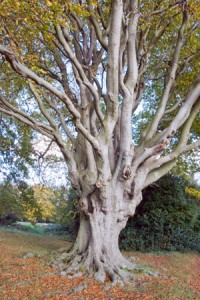Where did all the trees go ?

In terms of a ‘head count’ of tree species, Europe does not do well when compared to Asia or North America. There are approximately five hundred tree species scattered across Europe, whereas Asia and North America are home to some thousand species each. There is fossil evidence that tree species such as Liquadambar (Sweet Gums) and Liriodendron (Tulip tree) once lived here. So one might ask why did they disappear?
The answer may be due a combination of glaciation and topography. During the late Pliocene period, the global climate cooled and massive glaciers began to extend across the Earth’s surface. Glacial and interglacial periods followed in the Pleistocene or Quaternary Period; sometimes referred to as the Ice Age. As the glaciers moved relentlessly south, so plants (and animals) had to move and if they could not respond to this ‘challenge’ then they would die out. There was also the problem that in moving south, plants and animals would meet with physical barriers (for example, the Alps) to their movement or rather the dispersal of their reproductive structures - their fruits and seeds. Seemingly there were fewer barriers to movement on other continents.
However, that is not the whole story. As flora and fauna were ‘pushed’ south by the glaciers / climate, lots of species were being corralled into a relatively small area.  Suitable habitats for temperate tree species would have been somewhat limited - areas like the peninsulas of Spain, Italy and the Balkans might have offered opportunities for the temperature tree species. There would have been small bands of land (refugia) where some species could find a home - possibly on mountain sides. Asia and North America would have offered more land and suitable habitats for ‘migrating’ tree species.
Suitable habitats for temperate tree species would have been somewhat limited - areas like the peninsulas of Spain, Italy and the Balkans might have offered opportunities for the temperature tree species. There would have been small bands of land (refugia) where some species could find a home - possibly on mountain sides. Asia and North America would have offered more land and suitable habitats for ‘migrating’ tree species.
The tree species that we see in Europe nowadays are probably descendants of those species that were able to tolerate harsh winters and cooler growing seasons in the refugia, or they are descendants of drought tolerant trees that found a niche in low elevation but warmer regions of southern Europe.
Comments are closed for this post.
